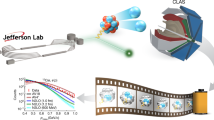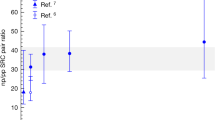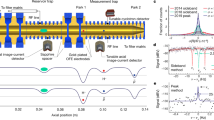Abstract
One of the primary goals of nuclear physics is to understand the force between nucleons, which is a necessary step for understanding the structure of nuclei and how nuclei interact with each other. Rutherford discovered the atomic nucleus in 1911, and the large body of knowledge about the nuclear force that has since been acquired was derived from studies made on nucleons or nuclei. Although antinuclei up to antihelium-4 have been discovered1 and their masses measured, little is known directly about the nuclear force between antinucleons. Here, we study antiproton pair correlations among data collected by the STAR experiment2 at the Relativistic Heavy Ion Collider (RHIC)3, where gold ions are collided with a centre-of-mass energy of 200 gigaelectronvolts per nucleon pair. Antiprotons are abundantly produced in such collisions, thus making it feasible to study details of the antiproton–antiproton interaction. By applying a technique similar to Hanbury Brown and Twiss intensity interferometry4, we show that the force between two antiprotons is attractive. In addition, we report two key parameters that characterize the corresponding strong interaction: the scattering length and the effective range of the interaction. Our measured parameters are consistent within errors with the corresponding values for proton–proton interactions. Our results provide direct information on the interaction between two antiprotons, one of the simplest systems of antinucleons, and so are fundamental to understanding the structure of more-complex antinuclei and their properties.
This is a preview of subscription content, access via your institution
Access options
Subscribe to this journal
Receive 51 print issues and online access
$199.00 per year
only $3.90 per issue
Buy this article
- Purchase on Springer Link
- Instant access to full article PDF
Prices may be subject to local taxes which are calculated during checkout




Similar content being viewed by others
Change history
18 November 2015
In the Methods, the equation for the equal-time reduced Bethe-Salpeter amplitude (which can be approximated by the outer solution of the scattering problem) was corrected.
References
STAR Collaboration. Observation of the antimatter helium-4 nucleus. Nature 473, 353–356 (2011); erratum 475, 412 (2011)
STAR Collaboration. STAR detector overview. Nucl. Instrum. Methods Phys. Res. A 499, 624–632 (2003)
Harrison, M., Ludlam, T. & Ozaki, S. RHIC project overview. Nucl. Instrum. Methods Phys. Res. A 499, 235–244 (2003)
Hanbury Brown, R. & Twiss, R. Q. A new type of interferometer for use in radio astronomy. Phil. Mag. 45, 663–682 (1954)
Yamazaki, T., Ishikawa, K., Kuramashi, Y. & Ukawa, A. Helium nuclei, deuteron, and dineutron in 2 + 1 flavor lattice QCD. Phys. Rev. D 86, 074514 (2012)
Riotto, A. & Trodden, M. Recent progress in baryogenesis. Annu. Rev. Nucl. Part. Sci. 49, 35–75 (1999)
Particle Data Group. Olive, K. A. et al. Review of particle physics. Chin. Phys. C 38, 090001, 96–106 (2014)
Schellekens, M. et al. Hanbury Brown Twiss effect for ultracold quantum gases. Science 310, 648–651 (2005)
Kiesel, H., Renz, A. & Hasselbach, F. Observation of Hanbury Brown–Twiss anticorrelations for free electrons. Nature 418, 392–394 (2002)
Rom, T. et al. Free fermion antibunching in a degenerate atomic Fermi gas released from an optical lattice. Nature 444, 733–736 (2006)
Goldhaber, G., Goldhaber, S., Lee, W. & Pais, A. Influence of Bose-Einstein statistics on the antiproton-proton annihilation process. Phys. Rev. 120, 300–312 (1960)
Kopylov, G. I. & Podgoretskiĭ, M. I. Interference of two-particle states in elementary-particle physics and astronomy. Sov. Phys. JETP 42, 211–214 (1975)
Podgoretskiĭ, M. I. Interference correlations of identical pions. Theory. Sov. J. Part. Nucl. 20, 266–282 (1989)
Gyulassy, M., Kauffmann, S. K. & Wilson, L. W. Pion interferometry of nuclear collisions. 1. Theory. Phys. Rev. C 20, 2267–2292 (1979)
Boal, H. D., Gelbke, C.-K. & Jennings, B. K. Intensity interferometry in subatomic physics. Rev. Mod. Phys. 62, 553–602 (1990)
Lednický, R. Correlation femtoscopy of multiparticle processes. Phys. Atom. Nucl . 67, 72–82 (2004)
Lisa, M., Pratt, S., Soltz, R. & Wiedemann, U. Femtoscopy in relativistic heavy ion collisions: two decades of progress. Ann. Rev. Nucl. Part. Sci . 55, 357–402 (2005)
Koonin, S. E. Proton pictures of high-energy nuclear collisions. Phys. Lett. B 70, 43–47 (1977)
Lednický, R. & Lyuboshitz, V. L. Influence of final-state interaction on correlations of two particles with nearly equal momenta. Sov. J. Nucl. Phys . 35, 770–788 (1982)
Lednický, R. Notes on correlation femtoscopy. Phys. Atom. Nucl . 71, 1572–1578 (2008)
STAR Collaboration. Proton-Λ correlations in central Au+Au collisions at
 . Phys. Rev. C 74, 064906 (2006)
. Phys. Rev. C 74, 064906 (2006)STAR Collaboration. Λ-Λ correlation function in Au+Au collisions at
 . Phys. Rev. Lett. 114, 022301 (2015)
. Phys. Rev. Lett. 114, 022301 (2015)Anderson, M. et al. The STAR time projection chamber: a unique tool for studying high multiplicity events at RHIC. Nucl. Instrum. Methods Phys. Res. A 499, 659–678 (2003)
STAR Collaboration. Multigap RPCs in the STAR experiment at RHIC. Nucl. Instrum. Methods Phys. Res. A 661, S110–S113 (2012)
Kisiel, A., Zbroszczyk, H. & Szymański, M. Extracting baryon-antibaryon strong-interaction potentials from femtoscopic correlation functions. Phys. Rev. C 89, 054916 (2014)
Chojnacki, M., Kisiel, A., Florkowski, W. & Broniowski, W. THERMINATOR 2: THERMal heavy IoN generATOR 2. Comput. Phys. Commun. 183, 746–773 (2012)
Pochodzalla, J. et al. Two-particle correlations at small relative momenta for 40Ar-induced reactions on 197Au at E/A = 60 MeV. Phys. Rev. C 35, 1695–1719 (1987)
ALICE Collaboration. One-dimensional pion, kaon, and proton femtoscopy in Pb-Pb collisions at . Preprint at http://arxiv.org/abs/1506.07884 (2015)
Mathelitsch, L. & VerWest, B. J. Effective range parameters in nucleon-nucleon scattering. Phys. Rev. C 29, 739–746 (1984)
Šlaus, I., Akaishi, Y. & Tanaka, H. Neutron-neutron effective range parameters. Phys. Rep. 173, 257–300 (1989)
Lednický, R. Femtoscopic correlations in multiparticle production and beta-decay. Braz. J. Phys. 37, 939–946 (2007)
Lednický, R. Finite-size effect on two-particle production in continuous and discrete spectrum. Phys. Part. Nucl. 40, 307–352 (2009)
Erazmus, B. et al. Influence of the emitting nucleus on the light-particle correlation function. Nucl. Phys. A 583, 395–400 (1995)
Gmitro, M., Kvasil, J., Lednický, R. & Lyuboshitz, V. L. On the sensitivity of nucleon-nucleon correlations to the form of short-range potential. Czech. J. Phys. B 36, 1281–1287 (1986)
Landau, L. D. & Lifshitz, E. M. Kvantovaya Mekhanika: Nerelyativistskaya Teoriya 3rd edn 585–685 (Nauka, 1974); Landau, L. D. & Lifshitz, E. M. Quantum Mechanics: Non-relativistic theory 3rd edn (Pergamon, 2013) [transl.].
Bodmer, A. R. & Usmani, Q. N. Coulomb effects and charge symmetry breaking for the A = 4 hypernuclei. Phys. Rev. C 31, 1400–1411 (1985)
Heller, L. Interaction of two nucleons at low energies. Rev. Mod. Phys. 39, 584–590 (1967)
Bergervoet, J. R., van Campen, P. C., van der Sanden, W. A. & de Swart, J. J. Phase shift analysis of 0–30 MeV pp scattering data. Phys. Rev. C 38, 15–50 (1988)
Acknowledgements
We thank the RHIC Operations Group and RCF at BNL, the NERSC Center at LBNL, the KISTI Center in Korea, and the Open Science Grid consortium for providing resources and support. This work was supported in part by the Office of Nuclear Physics within the US DOE Office of Science, the US NSF, the Ministry of Education and Science of the Russian Federation, NSFC, the MoST of China (973 Programme No. 2014CB845400), CAS, MoST and MoE of China, the Korean Research Foundation, GA and MSMT of the Czech Republic, FIAS of Germany, DAE, DST and UGC of India, the National Science Centre of Poland, National Research Foundation, the Ministry of Science, Education and Sports of the Republic of Croatia, and RosAtom of Russia.
Author information
Authors and Affiliations
Consortia
Contributions
All authors contributed equally.
Ethics declarations
Competing interests
The author declare no competing financial interests.
Extended data figures and tables
Rights and permissions
About this article
Cite this article
The STAR Collaboration. Measurement of interaction between antiprotons. Nature 527, 345–348 (2015). https://doi.org/10.1038/nature15724
Received:
Accepted:
Published:
Issue Date:
DOI: https://doi.org/10.1038/nature15724
This article is cited by
-
Hypernuclei as a laboratory to test hyperon–nucleon interactions
Nuclear Science and Techniques (2023)
-
Measurement of anti-3He nuclei absorption in matter and impact on their propagation in the Galaxy
Nature Physics (2023)
-
Nuclear dynamics and particle production near threshold energies in heavy-ion collisions
Nuclear Science and Techniques (2018)
-
Production of light nuclei and hypernuclei at High Intensity Accelerator Facility energy region
Nuclear Science and Techniques (2017)
-
Measurements of momentum correlation and interaction parameters between antiprotons
Nuclear Science and Techniques (2016)
Comments
By submitting a comment you agree to abide by our Terms and Community Guidelines. If you find something abusive or that does not comply with our terms or guidelines please flag it as inappropriate.




 . Phys. Rev. C 74, 064906 (2006)
. Phys. Rev. C 74, 064906 (2006) . Phys. Rev. Lett. 114, 022301 (2015)
. Phys. Rev. Lett. 114, 022301 (2015)